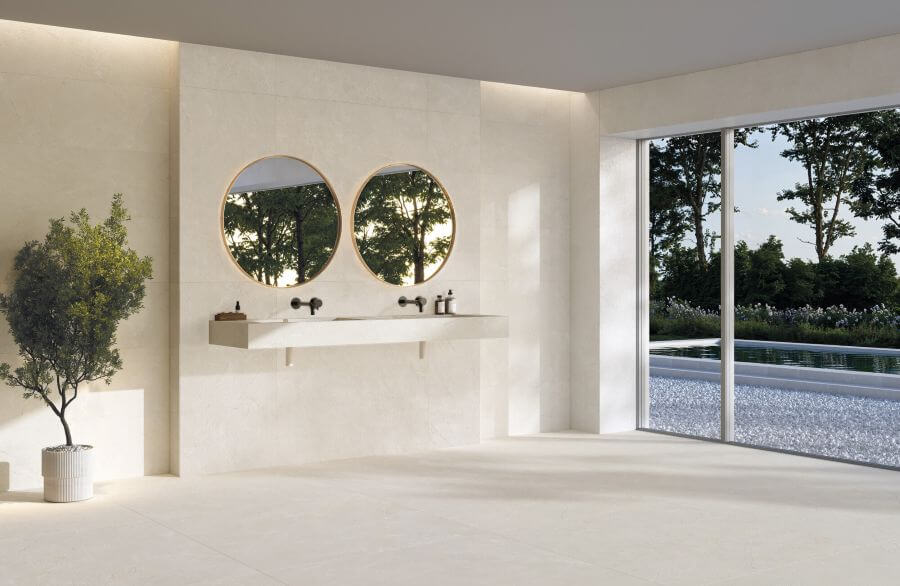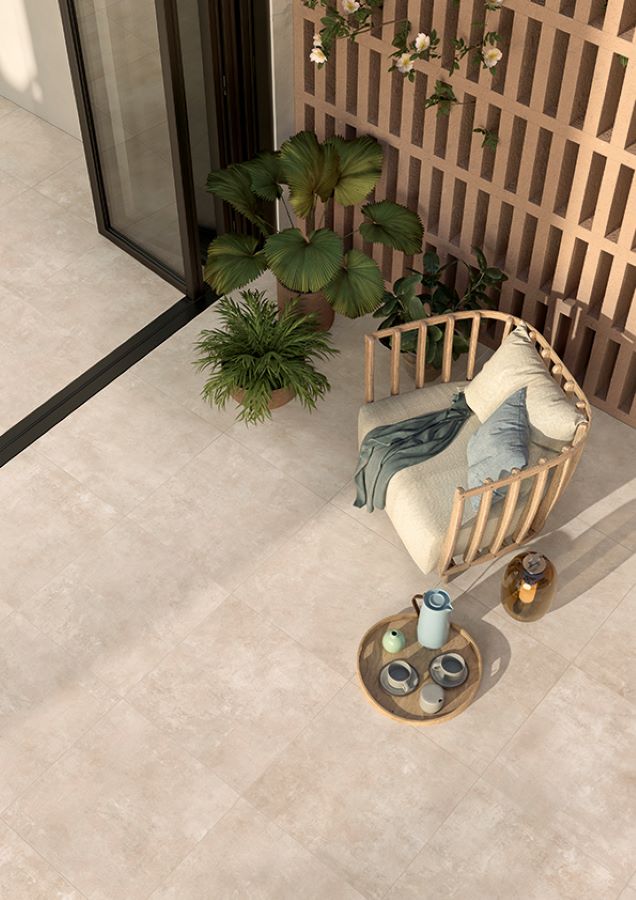
Are porcelain tiles good for bathroom walls? The material you pick for bathroom walls is an important one. Our blog explores this key question.
At the very least you will want to ensure walls are protected from water splashes and there are lots of material options that will do this whether that is a porcelain tile, ceramic tile, waterproof panelling or even waterproof wallpaper! However, as we will see, porcelain tiles are amongst the most hardwearing of the materials you can opt for. Add to that ease of cleaning, scratch and stain resistance, moisture resistance and design and this is a material that is absolutely great for bathroom walls and can bring far more than simple protection from water. Porcelain tiles can be used to create feature walls, add texture and depth to spaces, bring a pop of colour to rooms, diffuse or bounce light and much more as we will discover. So let’s explore more!
To be called porcelain, a porcelain tile has to have less than 0.05% water porosity. It’s one of the reasons porcelain can also be used externally because it is highly water resistant. This makes porcelain the perfect material for bathroom walls as they create a highly effect water barrier.
All this means you can use porcelain tiles with ease in the bathroom. From tiling a shower enclosure, porcelain can also be used behind the bath, behind a sink unit, around the WC. Of course, like all materials, professional installation is key to ensure your bathroom still looks beautiful in years to come and to avoid any water seepage through poor installation. This is critical too for wetrooms where there is no shower tray and areas require professionally tanking to ensure that water ingress does not occur.
This is where porcelain tiles really come into their own. Porcelain design has developed in leaps and strides over the past few years with tile technology delivering tiles that echo natural materials to exceptional standards. Whether it is metals, concretes, cements, micro cements, terrazzo, stone, marble or woods, high quality porcelain tiles mimic these materials so well it can be tricky to tell a porcelain tile from the real material.
Some of these natural materials have their drawbacks particularly in bathroom spaces eg timber can bend or wrap, natural marble is very soft and can wear unevenly and needs regular sealing, natural stone requires regular ongoing maintenance, metals can rust. Not so with porcelain. Porcelain is a very stable material and pretty much unalterable. It is very hardwearing, highly scratch resistant, highly stain resistant and very easy to clean so it lends itself to use throughout the home, and that includes even the busiest of homes.
In addition, gone are the days of just a few designs per tile. Now high-quality wood effect porcelain tiles include perhaps 30, 40, or even 50 different designs per tile and that brings ultra realism across spaces. Add to that tile finishes and some truly clever advances in technology and now there are tiles where pattern and surface texture align to not only look like wood, but to really feel like wood too.
All this means that whilst tiles can just perform a function to stop water splashes on walls, they can also add design, texture and the wow factor to bathrooms and particularly bathroom walls.
It can be interesting to mix up designs and textures. You may love a marble porcelain tile but don’t want to use it everywhere so adding in a matt concrete or cement effect floor tile and using your silk finish marble porcelains on the walls is a good way to not only make your marble tiles stand out as a feature but also to add a contemporary twist to a space.
Any great interior designer will tell you that rooms need different textures and the skill is combining the rough with the smooth successfully. Tiles are a great way of bringing different finishes to a space. With a whole host of options including matt, natural, gloss, polished, lapatto, soft, antislip and more, combining different tile finishes in the same space can open up design possibilities. How light plays with these textures in spaces will add interest too. Shiny surfaces eg glossy or polished finishes tend to reflect light where as matt finishes will absorb more light bringing a softer feel to spaces.
Porcelain tiles are just great for creating interesting feature walls with the wow factor. Think behind the bath, in the shower or on the wall facing you as you enter the bathroom. With incredible design, larger tile sizes or even smaller feature tiles, you really can go to town on creating a bathroom space that has the wow factor and add interest and colour to spaces. Cleverly combining a concrete effect tile for example that has a simpler tile design with a metallic, marble or feature tile can really make the latter stand out on a feature wall. Of course, smaller feature tiles will have lots of grout lines so you may want to keep this in mind when choosing porcelain tile sizes.

Porcelain is a highly durable material. A porcelain tile make-up and manufacturing process means it is about as hardwearing a material as you can get and that makes it ideal for busy bathrooms. Whether it is water, steam, splashes, soaps or cosmetics, a well installed porcelain wall tile is not prone to staining, chipping or cracking and is also super easy to clean.
Rectified tiles are tiles with a straight edge and the beauty of these tiles is that grout lines can be as think as a few mm on walls. Unlike natural stone with its tumbled edges and thicker grout lines, rectified tiles mean there is minimal grout. Add to that advances in grouts and grout protector sprays and there are options to help ensure your tiles and grout continue to look pristine.
Another huge benefit of porcelain for bathroom walls is the choice of tile sizes. For minimal grout, larger formats can be a great choice. Whereas huge formats such as 1200 x 1200mm tiles or 1m x 1m tiles were once the preserve of interior designers, these formats are making their way into our homes. Of course, these sizes can come at a cost so it is great that porcelains also come in smaller sizes too with 600 x 600mm or 600 x 300mm great go-to sizes for those not wanting to go too large.
As we have already discovered tiles can be used in a number of ways in bathrooms. These can be difficult spaces to design. Do you tile everywhere, or just tile half-height on all walls or only tile the walls where water is likely to be present eg in the shower, behind the bath or sink? Of course, cost will play a part in these decisions and there isn’t necessarily a right or wrong answer. This is more about the look you want to create in your bathroom space.
Porcelain tiles are perfect for bathroom floors too for all the reasons we have already covered. One additional consideration for floors is slip resistance particularly for wet rooms. Where you are standing on the tiles in the shower with water and then the addition of soap or shampoo sloshing around it is very important that tiles have a suitable slip rating eg a minimum R11 A+B+C, whilst also considering ease of cleaning. The grippier the tile surface, the trickier it can be to clean so it is worth getting some advice.
As we have already discovered, porcelain tiles are very hardwearing because they are so dense. It is this density that can make them trickier to cut than a ceramic tile. A ceramic tile is slightly softer than porcelain so can be easier to cut, however, ceramic doesn’t bring with it the hardwearing properties of porcelain. Porcelain is also heavier than ceramics which can be a consideration for walls. It’s important to always check with your tiler your chosen tiles before going ahead and to check the weight considerations for your walls.
So, in conclusion to our question, are porcelain tiles good for bathroom walls, the answer is yes they certainly can be. Porcelain tiles can be used simply as a trusted water barrier for walls at the very minimum in the shower enclosure, behind a WC or basin. Or, with such an array of beautiful designs they can be used throughout the bathroom and even allow for a statement making wall or two aswell with a wonderful feature tile. The possibilities are endless and exciting!
Click the images with a description underneath to head straight to these tiles on our website. You can order samples, request a quote or get in touch with us directly for more info!
We’d love to help! Get in touch and let us start searching for beautiful tiles with you!
If you would like to know more, please get in touch...
The TilePortfolio specialise in Italian and Spanish Porcelain and Ceramic tiles, in particular large format Porcelains and Porcelain tiles for inside and outside. Our carefully curated, stunning tile portfolios are beautifully presented online and supported by our fuss-free ‘go-the-extra-tile’ service. In addition, you can view our entire tile collection at our Northamptonshire Showroom. Visit our website for unmissable interiors inspiration. The TilePortfolio team are always available to chat, we’d be delighted to help with your project so please do get in touch.
Please note: We strongly recommend using a professional tiler for your project. Installation requirements may vary depending on the tiles you choose, the fixing products used and the specific conditions. Always check with your tiler regards the suitability of the tiles. Please get in touch with us if you have any questions.
